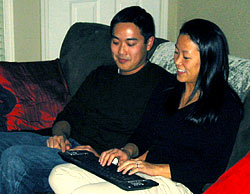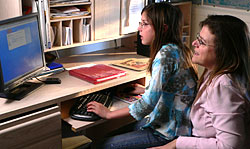REDMOND, Wash. Jan. 29, 2007 – Fifty families from seven countries lived with Windows Vista for nearly two years as part of the largest-scale consumer research program Microsoft had ever undertaken before a Windows launch.
In that time, participants say, life was good.

Brandon and Thuy Shimizu use a wireless keyboard in their Bellevue, Wash., home as part of the “Life with Windows Vista” program.
“Windows Vista has taken the whole concept of a computer and expanded it to something you can take out of the computer room and put in the family room,” says Thuy Shimizu, a Bellevue, Wash., resident who was asked to participate in the “Life with Windows Vista” program along with her husband, Brandon. “It’s not just an operating system; it’s a family entertainment system. I never thought that I would be taking my computer into my personal life. I’ve always associated computers with my work life. Not anymore.”
Microsoft credits the Shimizus and the other families – who were selected from focus groups and through various marketing methods – for helping design a system that is user friendly for all ages. Life with Windows Vista participants also helped identify more than 800 bugs during the two-year program, in addition to helping shape the software into what it is today by discovering and testing features that worked and didn’t work for them personally.
That feedback, says Trish Miner, research manager for the “Life with Windows Vista” program for Microsoft, was the point of their participation and critical to the development process.
“We wanted to make sure that our core customers were involved throughout the development life cycle and could clue us into what worked well and what did not,” Miner says. “We also wanted to make sure that everything they wanted to do with Vista, they could do easily. We encouraged them to try new things and test the features to the max.”
Robin Mason, a self-described “tech fanatic” from Phoenix, Ariz., did not need much encouragement in that arena.
Impacting How People Use Computers across the World
“I was beyond thrilled about being asked to participate,” says Mason, who test-drove Windows Vista with her husband and 12-year-old daughter. “I thought, ‘What an amazing opportunity to have an impact on this product and affect how people use computers across the world, and in my house.'”

“Life with Windows Vista” participants Robin Mason (right) and daughter Cassidy use their Windows Vista PC at home in Phoenix, Ariz.
Mason says she was surprised by how comprehensive Windows Vista is and how easy and fun it is to use. “I like to make my computer work for me,” she says. “I just kind of download everything in sight and try it out. But there is so much built into Vista, IE7 (Internet Explorer 7), the photo gallery, the screenshot tool, the parental controls, the sidebar, that I haven’t needed to download anything else. Everything I want is built right into Vista.”
As a result, Mason says, she began to experiment more than she ever thought possible, adding a TV tuner and another monitor to her hardware mix. Her daughter enjoys having her homework up on one screen and her research on the other.
Windows Media Center has also been a big hit with the whole family and has allowed Mason to hook it up to the Xbox 360 and display some of the 5,000 digital photos she has stored. In addition, she uses Photo Gallery for more than 20,000 scrapbooking images, and she appreciates the ability to find, use and tag all of them easily, a feature she helped improve through the Life With Windows Vista program.
User Feedback Carried Clout
It isn’t unusual for Microsoft developers to court public opinion on their products. It’s pretty typical for Microsoft and other software manufacturers to release beta versions, which involves sending the product outside the company for real-world exposure prior to a commercial release.
But the duration of the Life with Windows Vista program as well as the weight given user feedback in the final product makes it pretty unique, Microsoft’s Miner says.
“We think this program will result in a much more intuitive and successful operating system had we not sought such extensive feedback from average users,” she says. “We’re very excited about the improvements our families helped us make.”
Thuy Shimizu recalls having difficulty finding files with the first beta version, but she says the final version has a very useful, streamlined search function. Brandon Shimizu says he doesn’t recall any specific thing he didn’t like about Vista at first.
“But I do remember submitting a lot of unhappy faces in the beginning,” he laughs, noting how much better the system became in the past couple of years. So much better that the Shimizus, who used to spend on average, 15 to 20 minutes a day on their home computer for personal reasons, now use it all the time.
“We take it into the family room and play music there,” says Thuy Shimizu. We just got married last July in Hawaii, so we can burn DVDs, create slideshows for family and friends. We read the paper, get our stock info.
“Vista has definitely changed the way we live for the better.”




